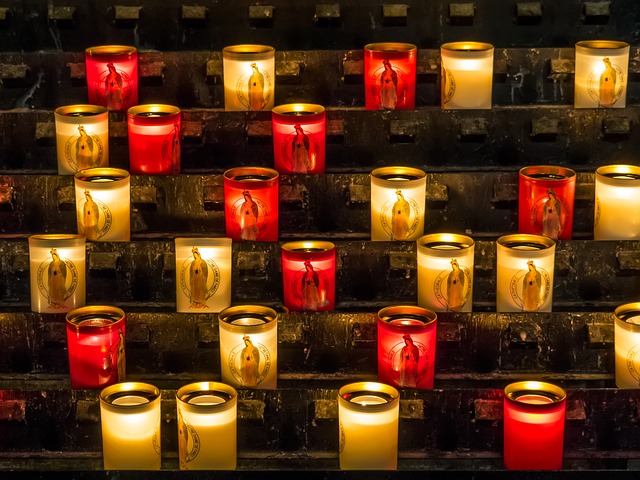Notre Père Who Art In Heaven – Our Father In French Posted by John Bauer on Apr 24, 2019 in Culture
The sad news in Paris last week left thoughts of Notre-Dame in everyone’s head all week. The incredible cathedral and all its art and history also made me realize an interesting connection it has to language.
Notre-Dame de Paris is renowned for its beauty and solid place in European history. Over the last millennium, Notre-Dame has proven its importance because of its connection to l’Église catholique (the Catholic Church).
Now it’s interesting to note that after la Revolution française (the French Revolution), the grand cathedral was no longer owned by le pape (the Pope). Despite that disconnection, it has remained an important and impressive place for la religion (the religion).
Similarly, even for me, someone not really connected to the church or religion, I can understand the importance of l’histoire de l’Église catholique (the history of the Catholic Church) in relation to Notre-Dame. That history can be felt, read, and heard very strongly in what is probably the most well-known prayer connected to le catholicisme (Catholicism):
Notre Père – The Lord’s Prayer, Our Father
Even if religion was never a big part of your life, it’s hard not to recognize the first few lines:
Notre Père, qui es aux cieux, que ton nom soit sanctifié.
Our Father who art in heaven, hallowed be thy name.
For language learners, Notre Père is also very useful as it is one of the most widely translated works across all languages on Earth.
There are also a few interesting historical bits specifically for French learners hiding in the history of la prière (the prayer).
Par exemple (for example), up until the late 19th century, Notre Père was only really ever recited en latin (in latin) in la francophonie (the French speaking world). That’s actually somewhat understandable since, after all, le français is a direct descendant of le latin!
As the millennia passed the prayer slowly became less and less understandable to le francophone lambda (the common French speaker). However, it wasn’t until the 1960s that an official version française (French version) of la prière was adopted by the church, but not without an interesting twist – especially for les anglophones (English speakers).
Before the shift in the 60s, the common version française used le vouvoiement (the “vous” form). To better reflect the history of the text that changed to the now official tutoiement (the “tu” form) used today.
This is particularly interesting for les anglophones because Notre Père is one of the only places that such a distinction still exits in English today. The seemingly odd use of “art thy name” is meant to reflect a close relationship like “tu” does en français!
It may still be hard to understand all the intricacies of being polite and knowing when to use “vous” and “tu”, but finding English equivalents definitley makes it more relatable.
With Notre-Dame de Paris and all the history of l’Église catholique recently in the news, take a moment to practice your French and listen to Notre Père en français:
Notre Père
The Lord’s Prayer, Our Father
Notre Père, qui es aux cieux,
que ton nom soit sanctifié,
que ton règne vienne,
que ta volonté soit faite sur la terre comme au ciel.
Donne-nous aujourd’hui notre pain de ce jour.
Pardonne-nous nos offenses,
comme nous pardonnons aussi à ceux qui nous ont offensés.
Et ne nous laisse pas entrer en tentation
mais délivre-nous du Mal.
[Car c’est à toi qu’appartiennent,
le règne la puissance et la gloire.
Amen.]
Our Father who art in heaven,
Hallowed be thy name.
Thy kingdom come.
Thy will be done on earth as it is in heaven.
Give us this day our daily bread,
and forgive us our trespasses,
as we forgive those who trespass against us,
and lead us not into temptation,
but deliver us from evil.
[For thine is the kingdom,
and the power, and the glory.
Amen.]

Build vocabulary, practice pronunciation, and more with Transparent Language Online. Available anytime, anywhere, on any device.





Comments:
P. K.:
It would be gender sensitive to have a woman as well as a man recite the Notre Pere. I can’t growl that low.
John Bauer:
@P. K. Hey P.K., merci pour votre commentaire ! Here’s a link to une version recited by a woman 🙂
https://www.youtube.com/watch?v=VhPr1lpUcSs
Lori:
Another interesting fact to talk about is the line towards the end “et ne nous laisse pas entrer en tentation” which is a recent change from the original line for which you have the English translation. There had been talk about changing the line to reflect our responsibility in not sinning here in the US, but nothing has been changed yet. This current line in the French prayer was changed in all of France to say “don’t let us enter into temptation “. French Catholics started using this revised version in December, 2017 and it puts the blame on us if we sin and not God.
Tammy:
There also exists a new sung version: Notre Père https://g.co/kgs/A2BGfj
by a group called Glorious…and it is.